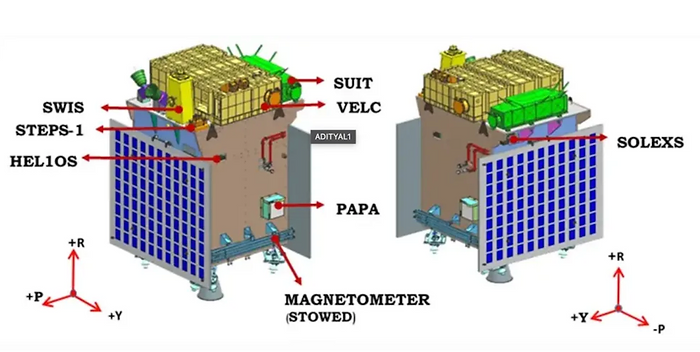Aditya-L1 mission, scheduled to launch on September 2, 2023 at 11:50 am (IST), will be the first space based Indian mission to study the Sun. It will be launched by ISRO’s PSLV XL rocket from Staish Dhawan Space Centre SHAR(SDSC-SHAR), Sriharikotha. The L1 in the title represents where the probe will be placed, around the Lagrange point 1 (L1), which is approximately 1.5 million km from the Earth. Aditya-L1 will take about 125 days(4 months) to reach Lagrange point 1(L1) from Earth.
The spacecraft is designed to carry seven payloads responsible to observe the photosphere, chromosphere, and the outer layers of the star (the corona). Four payloads will directly view the sun while the remaining three payloads will simultaneously perform in-situ studies of the particles and field at the Lagrange point, L1, allowing a better understanding of the effects of solar dynamics in the interplanetary medium.
Why at L1?
At the first Lagrange point, under the influence of the balanced gravitational forces of the Sun and Earth, the satellite will be able to maintain an undisturbed position in space. The major advantage of a satellite being located at the first Lagrange point is that it is not affected by any eclipses/occultation. The probe can be pointed directly towards the sun, hence the solar activities can be examined for longer periods in real time.
Why study the Sun?
Earth is constantly bombarded with solar winds, the energetic particles and wavelengths emitted by the sun. Due to a strong protective magnetic field, not all radiation is penetrated through the atmosphere of Earth. Hence, instruments from Earth are unable to detect 100% of the solar radiation and study solar activities. Studies however can be carried out by observing nearer to its origin. To understand how the solar wind particles and magnetic field from the sun travel through the interplanetary space, measurements can be taken from regions further from the range of Earth’s magnetic field.
Why is this mission unique?
- First time to spatially resolve solar disk in the near UV band.
- CME dynamics close to the solar disk evident to provide information in the acceleration regime of CME.
- On-board intelligence to detect CMEs and solar flares for optimised observations and data.
- Directional and energy anisotropy of solar wind using multi-direction observations.
Objectives of Aditya-L1 Mission
- Physics of solar corona and its heating mechanism.
- Study of the Solar upper atmospheric dynamics (chromosphere and corona).
- Study of chromospheric and coronal heating, physics of partially ionized plasma, initiation of coronal mass ejections, and flares.
- Observe in-situ particle and plasma environment providing data for studying particle dynamics from the sun.
- Diagnostics of the coronal and coronal loops plasma: Temperature, Velocity, and density.
- Capture the sequence of processes occurring at multiple layers of the Sun which are responsible for solar eruptive events.
- Magnetic topology and magnetic field measurements in the solar corona.
- Development, dynamics, and origin of CMEs (coronal mass ejection).
- Space weather (origin, composition, and solar wind dynamics).
Payloads

Payloads
Remote sensing Payloads:
- Visible Emission Line Coronagraph(VELC): Corona/Imaging & Spectroscopy
- Solar Ultraviolet Imaging Telescope(SUIT): Photosphere and Chromosphere Imaging-Narrow & Broadband
- Solar Low Energy X-ray Spectrometer(SoLEXS): Soft x-ray spectrometer
- High Energy L1 Orbiting X-ray Spectrometer(HEL1OS): Hard X-ray Spectrometer
In-situ Payloads:
- Aditya Solar wind Particle Experiment(ASPEX): Solar Wind/Particle Analyzer Protons & Heavier ions with directions
- Plasma Analyzer Package For Aditya(PAPA): Solar Wind/Particle Analyzer Electrons & Heavier ions with directions
- Advanced Tri-axial High Resolution Digital Magnetometers: In-situ magnetic field (Bx, By, and Bz)
Is Aditya-L1 a complete mission to study the Sun?
Unfortunately, this one mission is not complete to study the Sun due to the complexities of solar activities. The polar regions of the sun are not well studied as it is challenging to place spacecrafts in such orbits. The Sun’s polar dynamics and magnetic fields play an important role in deriving the solar cycles. Fortunately however, Aditya-L1 will provide a better understanding to the changing environmental conditions in space, the influence of solar winds on varying planets, how technology can be improved to withstand such conditions for longer survival, and result in various other factors.
With the fearless attempt to study the Sun, we all look forward to the research this mission has to offer as well as the improvement in technology for future missions influenced by the outcomes of ISRO’s Aditya-L1.
References
· Organisation: (ISRO) last updated: (2023) Title: (Aditya-L1) URL: (https://www.isro.gov.in/Aditya_L1.html) last accessed: (02/09/2023)